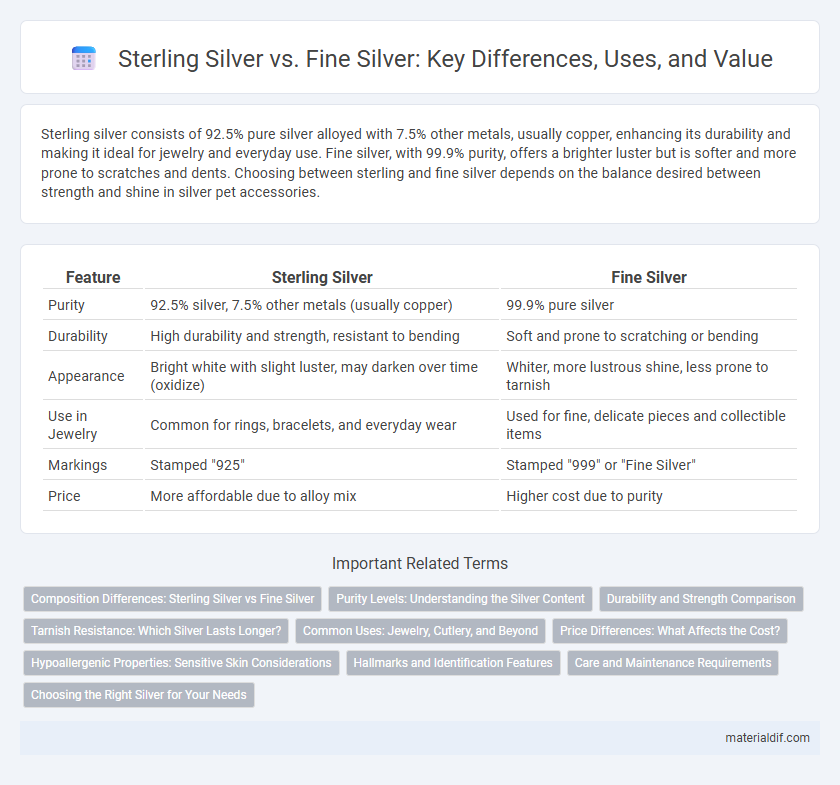Sterling silver consists of 92.5% pure silver alloyed with 7.5% other metals, usually copper, enhancing its durability and making it ideal for jewelry and everyday use. Fine silver, with 99.9% purity, offers a brighter luster but is softer and more prone to scratches and dents. Choosing between sterling and fine silver depends on the balance desired between strength and shine in silver pet accessories.
Table of Comparison
| Feature | Sterling Silver | Fine Silver |
|---|---|---|
| Purity | 92.5% silver, 7.5% other metals (usually copper) | 99.9% pure silver |
| Durability | High durability and strength, resistant to bending | Soft and prone to scratching or bending |
| Appearance | Bright white with slight luster, may darken over time (oxidize) | Whiter, more lustrous shine, less prone to tarnish |
| Use in Jewelry | Common for rings, bracelets, and everyday wear | Used for fine, delicate pieces and collectible items |
| Markings | Stamped "925" | Stamped "999" or "Fine Silver" |
| Price | More affordable due to alloy mix | Higher cost due to purity |
Composition Differences: Sterling Silver vs Fine Silver
Sterling silver is an alloy composed of 92.5% pure silver and 7.5% other metals, usually copper, which enhances its strength and durability for jewelry and utensils. Fine silver contains 99.9% pure silver, making it softer and more prone to scratches or deformation but highly valued for its purity. These composition differences significantly impact the metals' use, with sterling silver favored for everyday items and fine silver preferred for investment and high-quality craftsmanship.
Purity Levels: Understanding the Silver Content
Sterling silver contains 92.5% pure silver, alloyed with 7.5% other metals such as copper to enhance durability, making it ideal for jewelry and household items. Fine silver boasts a higher purity level of 99.9%, offering excellent softness and resistance to tarnish but reduced strength compared to sterling silver. Choosing between sterling and fine silver depends on the desired balance between purity, durability, and application.
Durability and Strength Comparison
Sterling silver, composed of 92.5% pure silver and 7.5% other metals such as copper, offers significantly greater durability and strength compared to fine silver, which is 99.9% pure silver. The added alloys in sterling silver enhance its resistance to scratching, bending, and everyday wear, making it ideal for jewelry and functional items. Fine silver's softness and malleability make it more prone to dents and deformation, limiting its use in high-stress applications.
Tarnish Resistance: Which Silver Lasts Longer?
Sterling silver, an alloy containing 92.5% silver and 7.5% other metals like copper, is more prone to tarnishing due to its metal alloys reacting with sulfur and moisture in the air. Fine silver, consisting of 99.9% pure silver, exhibits superior tarnish resistance because of its minimal alloy content, making it last longer in appearance. While fine silver resists oxidation better, sterling silver's increased durability often leads to a longer functional lifespan despite needing more frequent cleaning.
Common Uses: Jewelry, Cutlery, and Beyond
Sterling silver, composed of 92.5% silver and 7.5% other metals like copper, is widely favored for jewelry and cutlery due to its durability and resistance to tarnishing. Fine silver, which is 99.9% pure, is softer and often used in high-end jewelry and specialized applications where purity is paramount but less daily wear is expected. Both types extend beyond traditional uses, with sterling silver popular in household items and fine silver sought for collectible coinage and electronic components.
Price Differences: What Affects the Cost?
Sterling silver, composed of 92.5% silver alloyed with other metals, is generally more affordable than fine silver, which is 99.9% pure but softer and less durable. The manufacturing process and alloy composition of sterling silver lower production costs, making it a popular choice for jewelry and tableware. Market demand, purity, and craftsmanship intricacies directly influence the price differences between these two forms of silver.
Hypoallergenic Properties: Sensitive Skin Considerations
Sterling silver, composed of 92.5% pure silver and 7.5% alloy metals like copper, can sometimes cause allergic reactions in sensitive skin due to the presence of alloy metals. Fine silver, which is 99.9% pure silver, is generally hypoallergenic and less likely to cause skin irritation, making it a better choice for people with metal sensitivities. Choosing fine silver jewelry reduces the risk of allergic reactions and is recommended for those with highly sensitive skin.
Hallmarks and Identification Features
Sterling silver is typically marked with hallmarks such as "925," indicating 92.5% silver purity, while fine silver often bears a "999" stamp, denoting 99.9% purity. Sterling silver has a more durable alloy composition, commonly featuring copper mixed with silver, resulting in its characteristic slightly heavier and harder texture compared to the softer, pure fine silver. Identification features for sterling silver also include the presence of specific assay office marks and purity stamps, essential for authentication in jewelry and silverware.
Care and Maintenance Requirements
Sterling silver, composed of 92.5% pure silver and 7.5% other metals like copper, requires regular polishing to prevent tarnish caused by oxidation and environmental exposure. Fine silver, at 99.9% purity, is less prone to tarnishing but is softer and more susceptible to scratches and dents, demanding gentler handling and storage in soft cloth pouches. Both types benefit from avoiding exposure to harsh chemicals and humidity to preserve their luster and structural integrity.
Choosing the Right Silver for Your Needs
Sterling silver, composed of 92.5% pure silver and 7.5% other metals like copper, offers superior durability and scratch resistance, making it ideal for jewelry and everyday use. Fine silver, with a purity of 99.9%, boasts a softer texture and brighter luster, suitable for high-end collectibles and investment pieces where purity is paramount. Selecting the right silver depends on balancing the need for strength and wearability against the desire for maximum silver content and shine.
Sterling Silver vs Fine Silver Infographic

 materialdif.com
materialdif.com